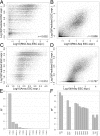ChIP-Seq of transcription factors predicts absolute and differential gene expression in embryonic stem cells
- PMID: 19995984
- PMCID: PMC2789751
- DOI: 10.1073/pnas.0904863106
ChIP-Seq of transcription factors predicts absolute and differential gene expression in embryonic stem cells
Abstract
Next-generation sequencing has greatly increased the scope and the resolution of transcriptional regulation study. RNA sequencing (RNA-Seq) and ChIP-Seq experiments are now generating comprehensive data on transcript abundance and on regulator-DNA interactions. We propose an approach for an integrated analysis of these data based on feature extraction of ChIP-Seq signals, principal component analysis, and regression-based component selection. Compared with traditional methods, our approach not only offers higher power in predicting gene expression from ChIP-Seq data but also provides a way to capture cooperation among regulators. In mouse embryonic stem cells (ESCs), we find that a remarkably high proportion of variation in gene expression (65%) can be explained by the binding signals of 12 transcription factors (TFs). Two groups of TFs are identified. Whereas the first group (E2f1, Myc, Mycn, and Zfx) act as activators in general, the second group (Oct4, Nanog, Sox2, Smad1, Stat3, Tcfcp2l1, and Esrrb) may serve as either activator or repressor depending on the target. The two groups of TFs cooperate tightly to activate genes that are differentially up-regulated in ESCs. In the absence of binding by the first group, the binding of the second group is associated with genes that are repressed in ESCs and derepressed upon early differentiation.
Conflict of interest statement
The authors declare no conflict of interest.
Figures



Similar articles
-
Integration of external signaling pathways with the core transcriptional network in embryonic stem cells.Cell. 2008 Jun 13;133(6):1106-17. doi: 10.1016/j.cell.2008.04.043. Cell. 2008. PMID: 18555785
-
Computer and statistical analysis of transcription factor binding and chromatin modifications by ChIP-seq data in embryonic stem cell.J Integr Bioinform. 2012 Sep 18;9(2):211. doi: 10.2390/biecoll-jib-2012-211. J Integr Bioinform. 2012. PMID: 22987856
-
Statistics of protein-DNA binding and the total number of binding sites for a transcription factor in the mammalian genome.BMC Genomics. 2010 Feb 10;11 Suppl 1(Suppl 1):S12. doi: 10.1186/1471-2164-11-S1-S12. BMC Genomics. 2010. PMID: 20158869 Free PMC article.
-
Role of ChIP-seq in the discovery of transcription factor binding sites, differential gene regulation mechanism, epigenetic marks and beyond.Cell Cycle. 2014;13(18):2847-52. doi: 10.4161/15384101.2014.949201. Cell Cycle. 2014. PMID: 25486472 Free PMC article. Review.
-
ChIP-Seq Data Analysis to Define Transcriptional Regulatory Networks.Adv Biochem Eng Biotechnol. 2017;160:1-14. doi: 10.1007/10_2016_43. Adv Biochem Eng Biotechnol. 2017. PMID: 28070596 Review.
Cited by
-
Genome-wide in silico prediction of gene expression.Bioinformatics. 2012 Nov 1;28(21):2789-96. doi: 10.1093/bioinformatics/bts529. Epub 2012 Sep 6. Bioinformatics. 2012. PMID: 22954627 Free PMC article.
-
Predicting cell-type-specific gene expression from regions of open chromatin.Genome Res. 2012 Sep;22(9):1711-22. doi: 10.1101/gr.135129.111. Genome Res. 2012. PMID: 22955983 Free PMC article.
-
lncRNA Signature for Predicting Cerebral Vasospasm in Patients with SAH: Implications for Precision Neurosurgery.Mol Ther Nucleic Acids. 2020 Sep 4;21:983-990. doi: 10.1016/j.omtn.2020.07.028. Epub 2020 Jul 25. Mol Ther Nucleic Acids. 2020. PMID: 32818922 Free PMC article.
-
RAR/RXR binding dynamics distinguish pluripotency from differentiation associated cis-regulatory elements.Nucleic Acids Res. 2015 May 26;43(10):4833-54. doi: 10.1093/nar/gkv370. Epub 2015 Apr 20. Nucleic Acids Res. 2015. PMID: 25897113 Free PMC article.
-
Integrating binding and expression data to predict transcription factors combined function.BMC Genomics. 2020 Sep 7;21(1):610. doi: 10.1186/s12864-020-06977-1. BMC Genomics. 2020. PMID: 32894066 Free PMC article.
References
-
- Mortazavi A, et al. Mapping and quantifying mammalian transcriptomes by RNA-Seq. Nat Methods. 2008;5:621–628. - PubMed
-
- Cloonan N, et al. Stem cell transcriptome profiling via massive-scale mRNA sequencing. Nat Methods. 2008;5:613–619. - PubMed
-
- Johnson DS, Mortazavi A, Myers RM, Wold B. Genome-wide mapping of in vivo protein-DNA interactions. Science. 2007;316:1497–1502. - PubMed
-
- Bussemaker HJ, Li H, Siggia ED. Regulatory element detection using correlation with expression. Nat Genet. 2001;27:167–171. - PubMed
Publication types
MeSH terms
Substances
Grants and funding
LinkOut - more resources
Full Text Sources
Research Materials
Miscellaneous

